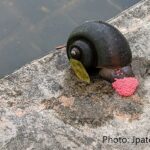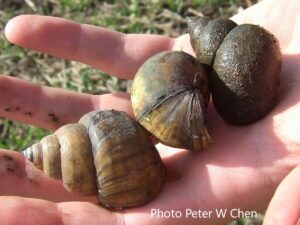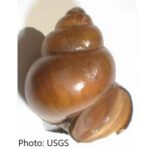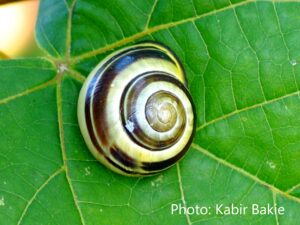Other Invasive Species Profiles:
American Bullfrog, Lithobates catesbianus – not known in CSRD
ALERT SPECIES
 American Bullfrogs are native to eastern North America. They were brought to BC as farm animals last century, farmed their meaty legs and some were released to form wild populations.
American Bullfrogs are native to eastern North America. They were brought to BC as farm animals last century, farmed their meaty legs and some were released to form wild populations.
Bullfrogs are large, smooth skinned, typically greenish with a lighter belly (sometimes yellow). They have a very large circular eardrum behind their eye with a skinfold following the rounded shape. They do not have parallel ridges running the length of their back.
Bullfrogs are not known to exist within the Columbia Shuswap Region. Please report any occurrences. These large frogs are generalist predators and eat other frogs, reptiles, small fish, baby birds, and even small mammals. Biodiversity plummets in many waterways where bullfrogs are established. Never release captive animals.
Learn to identify American bullfrogs with the Frog Identification key. Male bullfrogs have a very distinctive call during the summer breeding season, June – July. If you hear this sound, please report.
Learn to identify American bullfrog eggs – Amphibian egg identification key
Columbia Shuswap American Bullfrog Risk Assessment
Apple Snail, Ampullariidae spp.
ALERT SPECIES
Several species in the Ampullariidae family are known as Apple Snails. Apple snails have been sold in pet and aquarium stores due to their decorative shells, and ability to clean surfaces of algae buildup.
 When introduced to non-native areas, they can rapidly alter the aquatic ecosystems due to their aggressive feeding style and rapid growth rate. They are voracious and opportunistic, feeding omnivorous aquatic vegetation and other snail species. Apple snails are also amphibious and can survive seasonally in both terrestrial and aquatic environments. Distinguishing features of apple snails are a round shell, feeding tentacles near their mouth, and a breathing tube (siphon) that they use to breath while staying submerged. They also lay bright pink eggs.
When introduced to non-native areas, they can rapidly alter the aquatic ecosystems due to their aggressive feeding style and rapid growth rate. They are voracious and opportunistic, feeding omnivorous aquatic vegetation and other snail species. Apple snails are also amphibious and can survive seasonally in both terrestrial and aquatic environments. Distinguishing features of apple snails are a round shell, feeding tentacles near their mouth, and a breathing tube (siphon) that they use to breath while staying submerged. They also lay bright pink eggs.
Is your snail and Apple Snail?
Prevention is key. Do not purchase this species. Never release aquarium animals, plants or even aquarium water into waterways.
Chinese Mystery Snail, Cipangopaludina chinensis
ALERT SPECIES
 Chinese mystery snails have been sold in the pet and aquarium trade. They are a large species, which is able to out-compete native species and can reproduce rapidly to very high densities. They are able to retract into their shells, closing a shell door and thus survive out of water for up to four weeks. They have a very large, cone-shaped shell, up to 6.5 cm tall with 6-7 whorls. Juvenile snails are light brown while adults range from olive green to ruddy brown.
Chinese mystery snails have been sold in the pet and aquarium trade. They are a large species, which is able to out-compete native species and can reproduce rapidly to very high densities. They are able to retract into their shells, closing a shell door and thus survive out of water for up to four weeks. They have a very large, cone-shaped shell, up to 6.5 cm tall with 6-7 whorls. Juvenile snails are light brown while adults range from olive green to ruddy brown.
 Although known to infest some waterbodies on southern Vancouver Island, they are unknown from mainland BC.
Although known to infest some waterbodies on southern Vancouver Island, they are unknown from mainland BC.
Prevention is key. Do not purchase this species. Never release aquarium animals, plants or even aquarium water into waterways.
Banded Snail, Cepaea nemoralis
Common in many parts of the CSRD
 The banded or brown-lipped snail is a terrestrial invasive snail, native to Europe. The name comes not from the stripes around the shell, but from the brown band around the shell opening. Snails of this species can vary significantly in colour from red, to yellow or white, with or without stripes. Typically, these snails preferentially feed on detritus. .
The banded or brown-lipped snail is a terrestrial invasive snail, native to Europe. The name comes not from the stripes around the shell, but from the brown band around the shell opening. Snails of this species can vary significantly in colour from red, to yellow or white, with or without stripes. Typically, these snails preferentially feed on detritus. .
 Do not transport this species. Ensure plant pots and garden furniture are free of snails before transport.
Do not transport this species. Ensure plant pots and garden furniture are free of snails before transport.
Never dump garden waste in unapproved sites. Garden waste is accepted free of charge at CSRD landfill sites.
Where are the Aquatic Invasive Species?
BC
Alberta
USA
All species: Early Detection & Distribution Mapping Systems
All species: U.S Geological Survey
Invasive Mussel Monitoring: Aquatic Invasive Species Network
